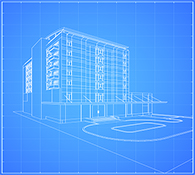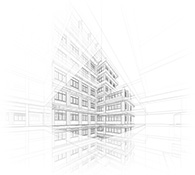
Linking Design to Outcomes: How Health Facilities Can Become Health Facilitators
What if we thought about our health facilities, as a key component of the patient’s treatment plan — not just providing the stage on which health delivery happens, but as an active component of the healing process as well. In this article we will explore how the built environment, via health facilities, can be a health facilitator.

Challenges of Converting Non-clinical Buildings to Healthcare Facilities
Try renovating a mall into a fertility centre or a bank into a neonatal intensive care unit or an office building into a long-term critical care facility and it is guaranteed challenging surprises will be encountered. This is when design firms get called in; specifically, creative teams who welcome challenges.

Developing Effective Value Analysis Committees
The cornerstone of a first-class equipment procurement initiative is a high functioning value analysis committee (VAC). Before the emergence of VACs, purchasing decisions were subject to influence by one or two key individuals. VACs are comprised of a diverse collection of individuals who are employed by the hospital.

Critical Success Factors for a Greenfield Hospital Project
In the last decade, healthcare has become a booming business in the Middle East. This is clearly seen by the number of Greenfield Hospital projects under development. A Greenfield development is defined as a project that is completely new or a start-up organisation, and in hospitals it usually refers to a newly constructed stand-alone facility.

Health Beyond a Hospital
Designing homes, offices and schools to support human health and well-being is frequently discussed in both academic and industry literature. But what about ‘third places’ such as retail establishments? The scale and prevalence of retail centres in the MENA region make them ideal spaces to promote health and wellness.

Evolving Role of the Medical Equipment Planner
Successful healthcare project planning is a dynamic process involving an entire team, typically comprising clinicians, architects, engineers and project managers, who are tasked with balancing the needs of patient care, and the realities of the design and construction process. However, there is a professional figure who plays a major role today in the creation of a cutting-edge hospital providing high patient satisfaction: the Medical Equipment Planner.

The Guiding Principles of Hospital Design and Planning
In an environment where failure to plan is planning to fail, time and time again poor planning can have devestating effects on the design and construction of healthcare facilities in both developed and developing markets. Despite the best intentions of providing healthcare to a growing market, the importance of infection control, staff efficiency, hospital workflow, as well as patient safety and comfort are often overlooked.

Smart Healthcare: Combatting Challenges Faced by a Transforming Regional Industry
Within the industry’s changing model of care — with an increasing focus on prevention and wellness, rather than a sickness model, and emphasis on collaboration across the sector, including public-private partnerships — digital technology has a vital role to play in supporting the aim of providing access to high quality, cost effective, sustainable and safe patient care, with improved medical outcomes.

Securing IoT Infrastructure in Seven Steps
IoT devices may offer extraordinary benefits to healthcare organisations in the Middle East. From improving patient outcomes, staff effectiveness and operational cost savings, it could also bring with them new security risks. Any type of a connected device is a potential risk, even wireless light bulbs, so it’s imperative that healthcare institutions do everything they can to stem the flow of malicious attackers. This calls for a multi-layered security approach to mitigate these threats.

Achieving Net Zero Energy for Hospital Buildings
Using the concept of a Net Zero Energy Building, one which produces as much energy as it uses over the course of a year, can further reduce dependence on fossil fuels by increasing use of on-site and off-site renewable energy sources. Net Zero Energy design depends on two key elements, the reduction of energy demands and the on-site production of energy.

Designing Spaces that Treat and Heal
Recently, global design firm Perkins Eastman announced the appointment of C. Carson Shearon, as the new Principal and Director of International Healthcare at Perkins Eastman. Shearon brings with him nearly 25 years’ experience in the health industry, and he capitalises on his multi-disciplinary training in the medical sciences and architecture to partner with clients in multiple cultures and marketplaces.

Driving Private Investment in Healthcare: Roles and Responsibilities of Regulatory Authorities
Despite many changes in recent years, rapidly evolving healthcare needs of the population and the scale of technology-induced change have led many to doubt the value and practicality of government regulation. Regulators and the regulations they create and enforce play a critical role — but one that may need to evolve to remain relevant and effective to keep up with the need for further investment.

What’s Easier: Implementing Health Reforms or Climbing Mount Everest?
Health systems around the world must face challenges like an aging population, chronic diseases, the evolution of tech, and the introduction of new medicines. While it is true that we are still in the beginning stages of defining a strategy to address these challenges, many countries are already working ‘side by side’, participating in reforms as a way to tackle these issues with an innovative and disruptive approach.

Dubai to Deploy Cutting-Edge AI devices in Healthcare
Utilising the latest medical technologies in Artificial Intelligence (AI) in a healthcare setting will improve efficiencies, health facility management and most-importantly enhance patient-care, says His Excellency Humaid Al Qutami, Director-General of DHA, while outlining the inventive healthcare innovations being adopted that will strengthen the authority’s medical system in both diagnosis and treatment.

The Power of Partnership
One of the notable trends witnessed in the region is that of local providers tying up with international healthcare brands or leading hospitals opening up branches locally and even working with distinguished doctors, in order to share their trusted expertise locally. The spectrum of collaborative endeavours is diverse in healthcare and involves international hospitals coming together to improve the culture of health in the local communities.

Seven Elements for Successful Healthcare Projects in the Middle East
Creating infrastructure in healthcare is no mean task. Projects are usually large-sized and involve adherence to many standards, regulations and best practices. If thrown into this the challenge of economic viability, it certainly is a daunting task at hand. The undertaking of creating healthcare infrastructure that is sustainable and viable is not impossible, even though it is a tough challenge.
Blindly off a Cliff
The tremendous positive impact that digitalisation and connectivity will have, specifically on healthcare staffing and facilities, will surpass the improvements in the public’s health afforded by the connection of sewage systems and having continual access to clean water, creating a paradigm shift after which their integration into medical practice will seem just as obvious and common sense as hygienic standards have become since the Victorian era.

Third-party Spend: A Key to Unlocking Healthcare Efficiencies
With an aging population bringing an array of health problems, healthcare providers are also facing a deluge of issues from new consumer trends, including urbanisation and more sedentary lifestyles along with dietary shifts from locally-grown, unprocessed food to more fast foods and sugary drinks. As a result, hospitals are seeing more chronic health issues from obesity and diabetes to hypertension and cardiovascular disease.

AI: Taking a Bigger Role in the Healthcare Conversation
Arab Health Magazine sat down with Rajat Karol, who is the general manager of GE Healthcare Digital for the Eastern Growth Markets & Africa to find out his taken on whether AI is a magic pill for the challenges we face in healthcare, or if we still have a long way to go before we see any real progress.


